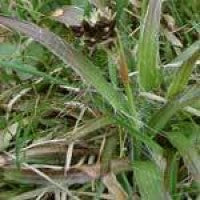Weed of the Week - Field Woodrush
Weed of the Week: Field Woodrush (Luzula campestris)
By Laurence Gale MSc
What is a weed? By definition a weed is a plant that is growing in the wrong place. Weeds take valuable space, water, sunlight and nutrients that may otherwise be accessible to important crops, in our case turf grasses. Weeds not only compete for these resources they can disfigure and cause problems to playing surfaces.
Weeds are very good competitors and take advantage of any opportunities to colonise turf situations, particularly when the sward is under stress and weak, leaving bare soil areas for weeds to populate. Weeds have many mechanisms and characteristics that enable them to do this, having thick waxy cuticle leaves that can be resistant to some chemicals, fast reproduction methods, the ability to reseed in 6 week cycles and deep tap roots enabling the weed to survive in compacted dry ground conditions.
Weeds have one of three life cycles: annual; biennial or perennial.
-
Annual weeds: Live for a single season. These weeds germinate from seed in the spring or summer, flower and then die.
-
Biennial weeds: Live for two seasons. During the first growing season, these weeds remain in a vegetative stage and, in the following year, produce flowers, set seed and die.
-
Perennial weeds: Live for multiple seasons and flower more than once. Perennial structures (rhizomes, stolons, crowns, entire plants or roots) survive from year to year.
Some weeds may be harmful to the environment or noxious to your regional ecology. For example Japanese Knotweed (Fallopia Japonica) is fast becoming a major weed problem on road side verges and urban landscape areas, a very difficult weed to eradicate. It is very important to recognise weeds and seek effective controls methods to eradicate them from our facilities.
Weeds can also be used as an indicator of soil conditions. For example, knotweed and plantains both indicate soil compaction because they can maintain adequate root respiration at lower oxygen diffusion levels than other plants. Different weeds tolerate different soil conditions, some are alkaline loving and others acid loving. Getting to understand and recognise the physiology of these plants will help you become better turfgrass managers.
This week's weed is: Luzula campestris (Field woodrush)
|
Scientific name Family Life cycle |
Luzula campestris Juncaceae Perennial |
|
|
Form / Appearance |
Field woodrush (Luzula campestris) is a grass-like, perennial weed. Belonging to the rush family. This species is common in short turf and can frequently be found as a weed in lawns. It can be identified by its tightly clustereds flowers and creeping rhizomes and it broad dark green leaves. |
|
|
Roots |
Field woodrush has fibrous roots and creeping stolons that enables the plant to spread and vegetatively reproduce its self. |
|
|
Flowers |
Clusters of brown flower heads are borne on stalks from April to May. The flowers are formed on a slender stalk (20cm) and have a shiny brown appearance. |
|
|
Leaves |
The leaves don't have auricles but have distinct fringed edges that have colourless hairs. The name Luzula is derived from the Latin name for Glow-worm (luciola).
|
|
|
Reproductive method |
The plant reproduces by seed and stolons |
|
|
Habitat |
It is common in acid conditions, especially where thatch (accumulated dead, fibrous material) has built up and increased acidity. Under such conditions grass growth is too weak to prevent this troublesome weed from establishing. Field woodrush even grows in chalk and limestone areas where the upper layer of soil has become acidic, due to rainfall and acid-reaction fertilisers such as sulphate of ammonia.
|
|
|
Cultural Control |
However, to eradicate the weed, liming is necessary. Apply ground chalk or ground limestone in late autumn or early winter, after mowing has ended, at 60g per sq m this will help raise the soil Ph. |
|
|
Chemical Control |
Apply selective broadleaf herbicides when plant growth is active. There are a number of products available for controlling broad leaf weeds in established turf. These chemicals are best used when the weeds are actively growing, usually between April-October.
These herbicides are usually applied as a liquid using watering cans, knapsack sprayers and vehicle mounted sprayers. Ensure you follow manufacturer's directions, health & safety and product data sheets, and comply with COSHH regulations when using these chemicals. Herbicides are an effective tool where high quality turf is desired. However, they must be applied with care and accuracy and in the context of a good overall turf management programme. Before using any herbicide, carefully review the label for conditions of use including rates, methods of application, and precautions. Never use a herbicide in any manner contrary to its label and be sure that the herbicide will not injure the turfgrass species.
|
|




